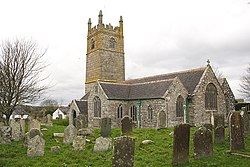Sithney
| Sithney Cornish: Merthersydhni | |
| Cornwall | |
|---|---|
 Sithney Church | |
| Location | |
| Grid reference: | SW643286 |
| Location: | 50.111187, -5.297777 |
| Data | |
| Postcode: | TR13 |
| Local Government | |
| Council: | Cornwall |
Sithney is a village in western Cornwall, a little to the north-west of Helston, and north of Porthleven. The population at the 2011 census was 836.[1]
The village is named after St Sithney, the patron saint of the parish church.[2] (The name of Goldsithney also comes from this saint.) St Sithney is said to have been one of the band of Irish missionaries who came to western Cornwall in the 'Age of Saints'. William Worcester recorded in 1478 that the body of the saint lay within the church.
History
Church
In 1230 the church belonged to the Antrenon family who attached to it a charge of 4 shillings yearly to the priory of St Germans. In 1267 it was appropriated to Glasney College; the last rector ceded his benefice to the college in 1270.[3]
The parish church is of Norman foundation but the present structure is more or less of the 15th century. The old Norman font of this church was removed to the new church of Carnmenellis (since demolished). A 13th century coffin slab was brought to the church from St Johns.[4]
In the churchyard is a monument to John Oliver, 1741. John Rogers, the landowner, mineral lord and biblical scholar, is buried here.[5]
Bridges
The bridge across the main road has two dates carved into granite stones; 1833 and 1861 after it was completed. Nearer Sithney Common Hill stands St. Johns Bridge, (Helston Bridge) that, although originally completed by 1260, has only the central west archway section remaining. Otherwise, the older sections left were built in the 16th century.[6]
Hospitals and houses

At St Johns in thr parish, near Helston Bridge, a hospital was founded c. 1250 by Henry de Bollegh, Archdeacon of Cornwall, and endowed with the manor of Penventon by the Reskymer family.[7] This foundation consisted in 1324 of a prior and two brethren. The hospital was abolished in 1545; by this time the priors had been non-resident for 50 years, the building was ruinous and a lone chaplain served the chapel. A leper hospital was founded nearby in the 15th century and dedicated to St Mary Magdalene.
At Truthall was the mediæval mansion of the Nance family which has an old chapel of c. 1500.[8] The mansion forms the right wing of Truthall farmhouse; the centre is dated 1642 and the left wing modern.[9] The gate piers and courtyard wall adjoining Truthall and Truthall House are Grade II* listed. Truthall was recorded in the Domesday Book (1086) as having half a hide of land. It was part of the royal manor of Winnianton.[10]
School
Since 1912 there has been a small school about half a mile away from the village. The school is called Sithney Community Primary School and has 36 pupils. The accommodation includes three classrooms, a hall, and a pre-school room. Outside there is a playground and a field with play equipment.
Outside links
| ("Wikimedia Commons" has material about Sithney) |
References
- ↑ Information on Sithney from GENUKI
- ↑ Mills, A. D. (1996). The Popular Dictionary of English Place-names. Parragon Book Service Ltd and Magpie Books. p. 298. ISBN 0-7525-1851-8.
- ↑ Cornish Church Guide (1925) Truro: Blackford; p. 195
- ↑ Cornish Church Guide (1925) Truro: Blackford; p. 196
- ↑ Rogers, John (1778–1856), divine: Dictionary of National Biography Vol. IL
- ↑ Russell, Stephanie. "Historic characterisation for regeneration – Helston" (PDF). Cornwall & Scilly Urban Survey. Cornwall Archaeological Unit, page 38, under section 8.
- ↑ Henry/Thomas de Bolegh, Archdeacon of Cornwall 8 July 1282–bef. 1296; however "c. 1250" is the date given by Charles Henderson in the Cornish Church Guide
- ↑ Cornish Church Guide (1925) Truro: Blackford; pp. 195-96
- ↑ Pevsner, N. (1970) Cornwall; 2nd ed., revised by Enid Radcliffe. Penguin; p. 236
- ↑ Thorn, C. et al. (1979) Cornwall, Chichester: Phillimore; entry 1,1
